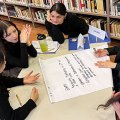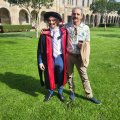Apple’s iTunes U is the final destination for a collaborative project between first year UQ physiology students and communication students.
The students in each cohort have teamed up to produce a short health literacy video which explains the underlying physiological basis of common medical conditions such as diabetes, emphysema, strokes, and hypertension.
As part of the project, Physiology of the Human Body, students were asked to write a video production brief setting out the physiological science involved in these conditions.
The brief was assessed for scientific accuracy and rigour. From here, PR Writing students converted the brief into a script and storyboard, which, after assessment for veracity and creativity, was produced as a video of no more than four minutes in length.
The final cut was vetted by the physiology students for accuracy and scientific integrity.
The project, designed by Dr John Harrison from UQ’s School of Journalism and Communication and Dr Hardy Ernst from UQ’s School of Biomedical Sciences, is funded by a UQ Strategic Teaching and Learning Grant from the Deputy Vice-Chancellor (Academic).
The interdisciplinary, cross campus collaboration has been facilitated through an online collaboration platform constructed by Matthew Taylor and his team from the UQ’s Centre for Biological Information Technology.
The platform enabled student teams in both locations (Ipswich and St Lucia) to upload their outputs into shared spaces, and to dialogue about those outputs.
Twenty-nine separate videos have been produced through the collaboration.
The process embedded in the project serves several purposes, according to Dr Harrison.
“Science has an emerging credibility crisis, evidenced by public skepticism about the science of global warming, and questioning of the authenticity of peer review," Dr Harrison said.
"In response, some have called for better public relations by scientists.
"This project is both timely and strategic because it engages both current national interest priorities, and the broader international agenda of science and health communication.
“It not only equips future health science professionals to use new media to communicate the science to non- professional audiences, but also equips future communication professionals to interpret a technically complex brief, and render it accurately for non-scientific audiences.”
The project is set to be a continuing collaboration between the Schools, with the intention of developing new learning materials for mobile “anywhere, any time learning”.
Media: Dr John Harrison (School of Journalism and Communication) 3346 8234, j.harrison@uq.edu.au or Helen Burdon (Marketing and Communications Manager, Faculty of Social and Behavioural Sciences) 3346 9279, h.burdon@uq.edu.au
.jpg)


.png?itok=xWvYRDbm)





